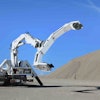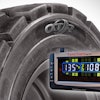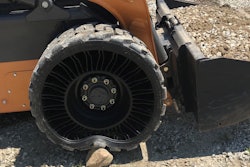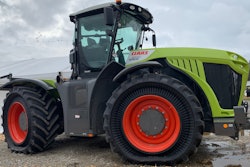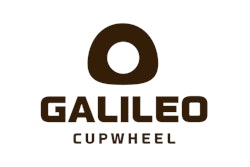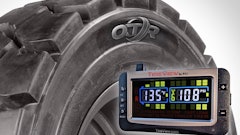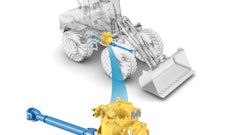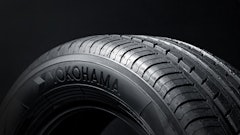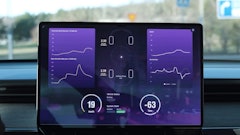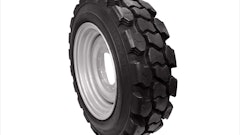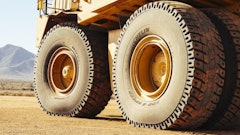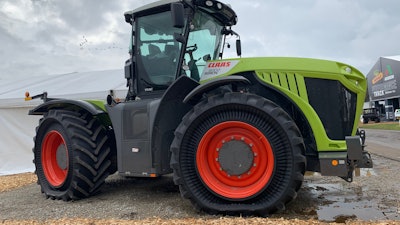
Galileo Wheel Ltd. recently introduced its CupWheel Tire to the heavy-duty equipment market. The accordion-shaped, airless tire touts increased rider comfort, improved traction and stability, and reduced soil compaction for off-road industries such as agriculture, construction, mining and forestry.
“You get better ride comfort, better lateral stability and a bigger footprint, which means more traction and less compaction,” says Avishay Novoplanski, CTO and co-founder of Galileo Wheel. “And in the event you get a puncture, it can limp home.”
Cup design
Novoplanski describes the CupWheel design as two inverted cups, or a v-shaped cross section, which allows for high flexibility.
“What we’re doing with this cup shape is, we’re taking advantage of the fact that this shape is very flexible, as everyone knows,” he says. “Everyone has held a paper cup. It’s very flexible in this (horizontal) direction and actually, you can see it almost looks like a (rubber) track.”
The CupWheel’s similarity to a track, like those found on compact track loaders and other equipment, is one of its strongest features, Novoplanski says.
“Altogether, when we say as a product it’s a tire--it sits on a standard trim, it’s manufactured in a tire factory utilizing the same machinery, the same production line--yet in properties, it’s closer to a track,” he says. “So, it’s the simplicity of a wheel with the properties of a track. That’s the beauty of it. We’re utilizing the same production method that exists in any tire factory, only we are piling up the things in a different way to create a totally different product.”
That increased flexibility, he says, leads to a larger footprint.
“The unique design allowed us to inflate this casing (tire) without having it bulging out (like an air-filled tire would) and once we achieved that we gained lots of properties; among them the large footprint,” Novoplanski says.
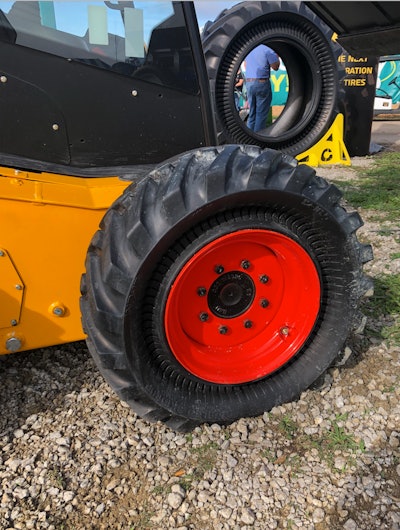 Even if punctured, the CupWheel enables operators to still drive their vehicle until they can fix the tire.S. Jensen
Even if punctured, the CupWheel enables operators to still drive their vehicle until they can fix the tire.S. Jensen
Vertical load
The tire has vertical load, which is the force applied to the tire, perpendicular to the ground. That vertical load compresses the tire, creating a larger footprint. The increased footprint allows for reduced ground pressure and soil compaction, as well as lateral stability for tight turns.
“A tire is basically a casing that contains air,” he says. “We use this air to suspend the ride on the surface. The air acts as a gas that can compress, and this acts as the first means of suspension for many vehicles. But if we want to gain a bigger footprint or we want a softer ride, we use lower air pressure. It makes everything more flexible but at the same time, we are losing some of the rigidity, the lateral stiffness, that is necessary in order to control and maintain steering-ability of the vehicle.”
Novoplanski says the design and properties of the CupWheel allow the tire to maintain flexibility and rigidity simultaneously.
“We can control the amount of flexibility,” he says. “You can imagine that if we fill this (cup) with air, we can control how much of the formation we want, but all that has nothing to do with the stiffness of this (cup) shape in this (horizontal) direction. So, if that would be a wheel, it would be as flexible as I want, through control by air pressure, but maintain the same stiffness at all times. Non-proportional stiffness in one direction versus very high flexibility in that other direction. This is the whole principle of this tire.”
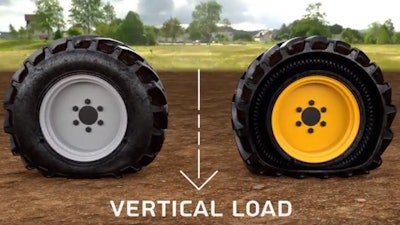 The Galileo CupWheel tire manages vertical load, creating a larger footprint.Galileo
The Galileo CupWheel tire manages vertical load, creating a larger footprint.Galileo
Puncture resistant
The CupWheel can also be driven at 0 bar (0 psi) air pressure, also known as integrated run-flat capability. This means that the tires can continue to be used even in the event of a puncture.
“One of the main issues with tires is punctures,” Novoplanski says. “We can run this tire at very low pressure. Even with no air, you can limp home. If you have a puncture, if you have a flat tire, you can limp home, you can fix it in a convenient environment. No more bringing all the rescue equipment to the middle of the field, etc.”
The tread formation works to protect the sidewalls from foreign objects.
“Not only is it protecting it, it’s not adding anything to the overall width of the machine,” he says.
The tire is thick enough that punctures would be rare, but if one occurs, the tire can likely be fixed.
“First of all, it’s very unlikely to get a puncture in the sidewall; if something gets to the sidewall, the sidewall is very, very thick, very unlikely to be penetrated, and even if something penetrates the sidewall, it is possible to fix it. If there was a slit in a normal tire, most of the time it would be a total loss for the tire,” he says. 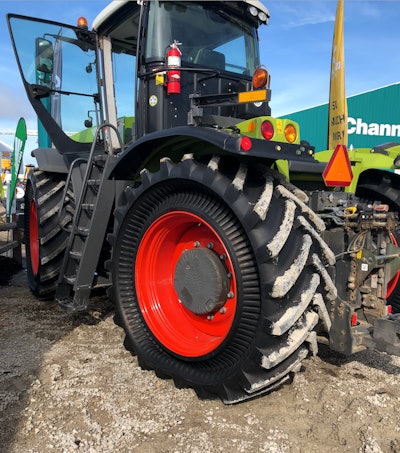 The v-shaped cross section of the CupWheel allows for high flexibility.S. Jensen
The v-shaped cross section of the CupWheel allows for high flexibility.S. Jensen
Ride comfort
The CupWheel’s large footprint and overall design lead to a smoother ride for operators, says Novoplanski.
“Ride comfort is much better with this tire,” he says. “That would maybe be the first thing you would ever notice, which is very important.”
Typically, a smoother ride means low air pressure, which reduces lateral stability in tough environments. That’s not so with the CupWheel, he says.
“In any vehicle, the tire would be the first means of suspension,” he says. “But if the tire is soft, if it gives good ride comfort, then it takes away lateral stability, because at the same time the tires need to be very stable, very rigid. So there's a contradiction here. If you gain ride comfort and a good footprint, you lose stability.”
The CupWheel capitalizes on the tire’s geometry to create stability in one direction and in another direction, a soft ride.
“Now, if you look at this shape, the cup shape has a very unique thing: it is very soft and flexible in one direction, and very stiff, non-proportionally stiff in another direction,” Novoplanski says. “So we utilize these shapes” to get both comfort and stability.
With its CupWheel design, Galileo Wheel is providing a new tire design to the heavy equipment industry which can create a safer, more comfortable operating experience while also reducing compaction and downtime.



